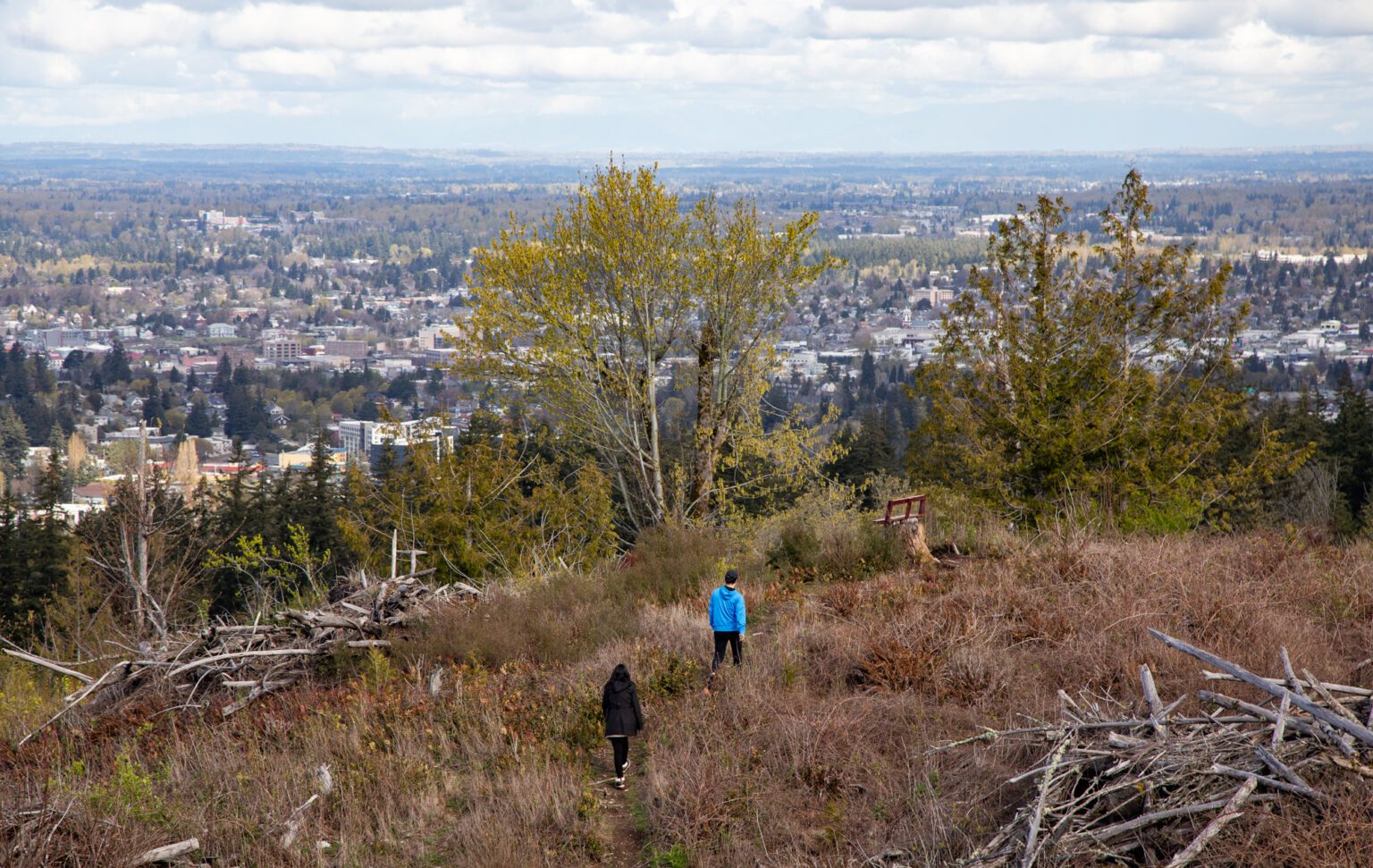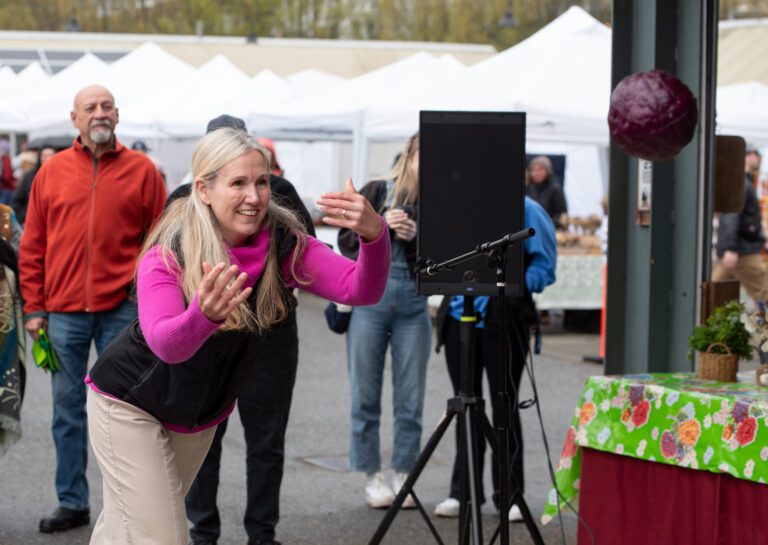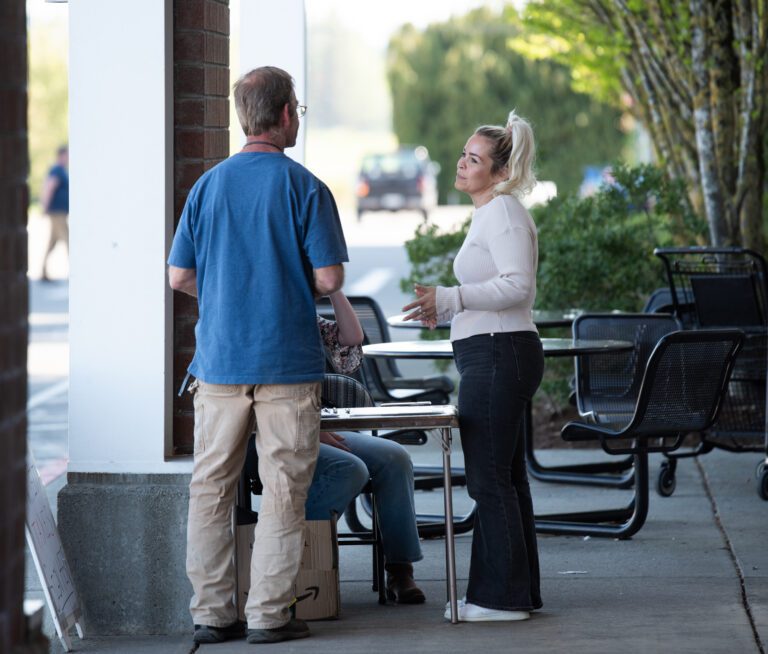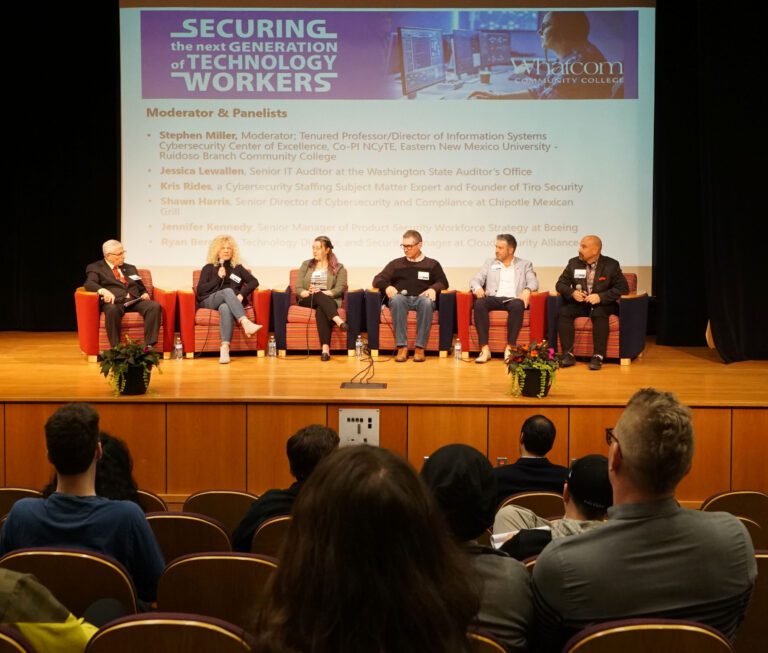In a city increasingly desperate for more housing, a large swath of undeveloped private land on Bellingham’s hilly eastern city limits has sat quiet for decades.
This is much to the delight of Bellingham residents who treat the area like a backyard park. Dog walkers, birdwatchers and cyclists are habitual users of a 111-acre plot that’s already logged, crisscrossed with social trails — and long intended to become fully built Samish Heights, a luxury housing development with expansive views.
What users might not know is that lagging infrastructure — including available water and road access through existing neighborhoods — has delayed or even cast doubt on original development plans. The same question marks have complicated possible sale of the property, listed at $31 million.
There’s been a lot of interest in the unique ridgetop property, said listing agent Elaine Prestlien of Muljat Group Realtors. Prestlien represents owner Jack Seguin, an Albertan tar sands tycoon and chocolate wholesaler who purchased a big swath of Bellingham land in the 1970s when the Canadian dollar was strong.
Under its current zoning, Samish Heights, one of the last large-acreage sites in the city, could be home to some 200 spacious residential lots with sweeping views of Bellingham Bay, the San Juan Islands, and British Columbia’s Coast Mountains. But once Prestlien starts to explain the situation to presumptive buyers, the calculus gets a little more complicated.
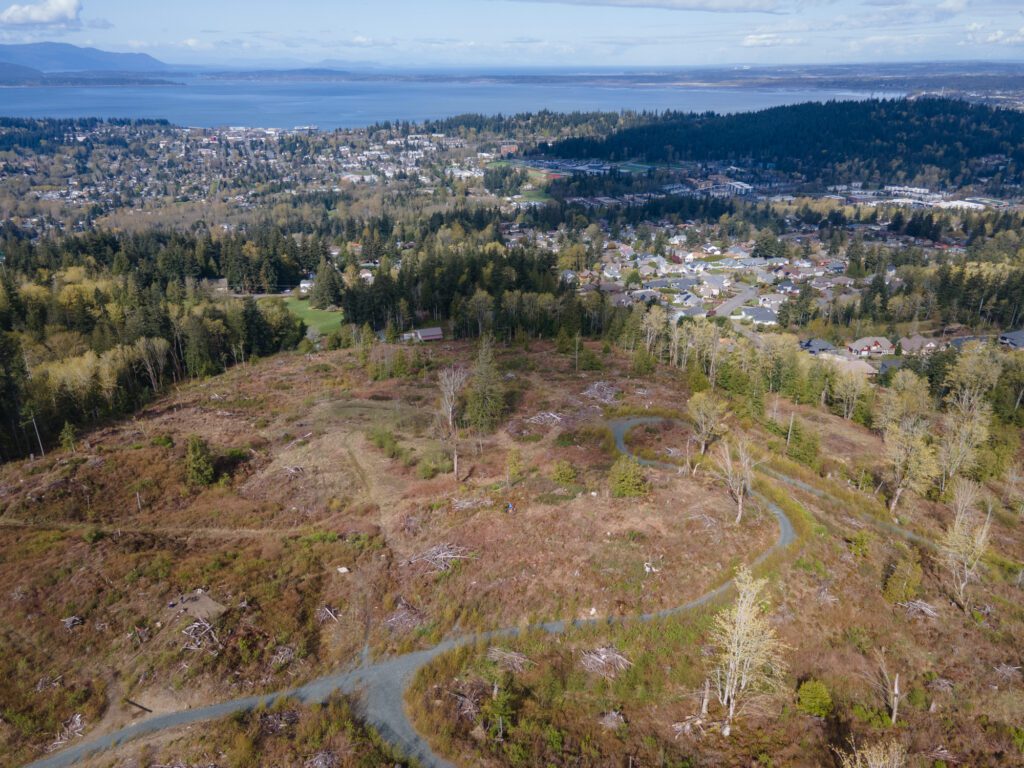
Right now, Seguin’s property, as well as a 40-acre parcel to the north owned by Bellingham’s Angell family, is essentially undevelopable. The land lacks city infrastructure, particularly adequate water pressure and road connectivity.
“Water and traffic are the two biggest unknowns on the hill at this moment,” Bellingham senior planner Kathy Bell said. She has been in the city planning office long enough to see several attempts to get Samish Heights off the ground.
A few roadblocks
Surveyor and engineer Ron Jepson, who has shepherded Seguin’s Bellingham projects since the 1990s, says the story of Samish Heights is one of long-standing frustration with city and county actions (or inaction).
Almost 30 years ago, the city identified the need for a reservoir atop Samish Hill to provide water pressure and storage for future development. In 2004, the city council decided to delay the water project, now scheduled to be constructed in 2028.
Similarly, in the city transportation plan, a connector road between Yew Street and Samish Way, as well as an area north-south connector, is listed as a requirement for development in the area, to ease pressure on Lakeway and divert traffic away from quiet roads in the Puget and Samish neighborhoods that lie below. The city set out to build the east-west connector, San Juan Boulevard, in 2006 with help from a $6 million federal grant, but abandoned the project due to cost and other factors.
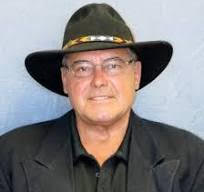
No city funds are now allocated to build the connector — but it remains a prerequisite to development. In 2018, Jepson, representing Seguin and the Angells, unsuccessfully applied to remove the road requirement from the city’s comprehensive plan. Jepson said he still believes the city should prioritize an east-west connector, which is a belief shared by the Samish Neighborhood Association. But he doesn’t believe the entire onus of the project should fall on private property owners.
Meanwhile, over on Yew Street just outside of city limits, the Whatcom County Council voted in 2009 to remove a large amount of land from the city’s urban growth area. That decision meant that no subdivisions on the southeast side of Samish Hill could be connected to city services, and many property owners who could have helped bear the cost of roads and water storage were removed from the equation.
“That’s one more barrier to regional planning,” said Ali Taysi of AVT Consulting, who is working as a consultant for Samish Heights. “That planning and utility policy created the dynamic where we now have had a property that’s totally within the city, sitting vacant for 20 years.”
Jepson thinks movement may be on the horizon. Bellingham, as part of its 2025 comprehensive plan update, is undertaking a deep dive into public and private utilities and infrastructure, which will include revisiting planned road connections.
But greenlighting development is no longer as simple as just changing the road requirement or hastening the water tank construction, Bell said.
“When we start removing things, then we have to understand and identify what that does to the overall system, and that’s the analysis that the public works department is doing,” she said.
“I’ve often wondered, should there be a commercial node up there? Should there be a fire station up there? What is truly needed to benefit this area?”
— Bellingham senior planner Kathy Bell
While not specifically called out in Bellingham’s most recent transportation plan from 2016, neighborhoods on Samish Hill would also benefit from an arterial emergency egress in case of a wildfire, a burgeoning concern in Western Washington.
The area, adjacent to city park property and other forest lands, was identified by the state Department of Natural Resources as a wildland-urban intermix (an area where housing intermingles with some wildland vegetation) with light to medium fuel loading; the city is currently developing an Urban Forestry Management Plan, which will include fire resiliency.
Hundreds of houses?
Another element of the comprehensive plan update is an in-depth review of city zoning, including that of the Samish Hill area, which allows 2.2 houses per acre, not including accessory dwelling units. That density could increase in the future.
“I don’t know what it’s going to end up being from a density perspective,” Bell mused. “I’ve often wondered, should there be a commercial node up there? Should there be a fire station up there? What is truly needed to benefit this area?”
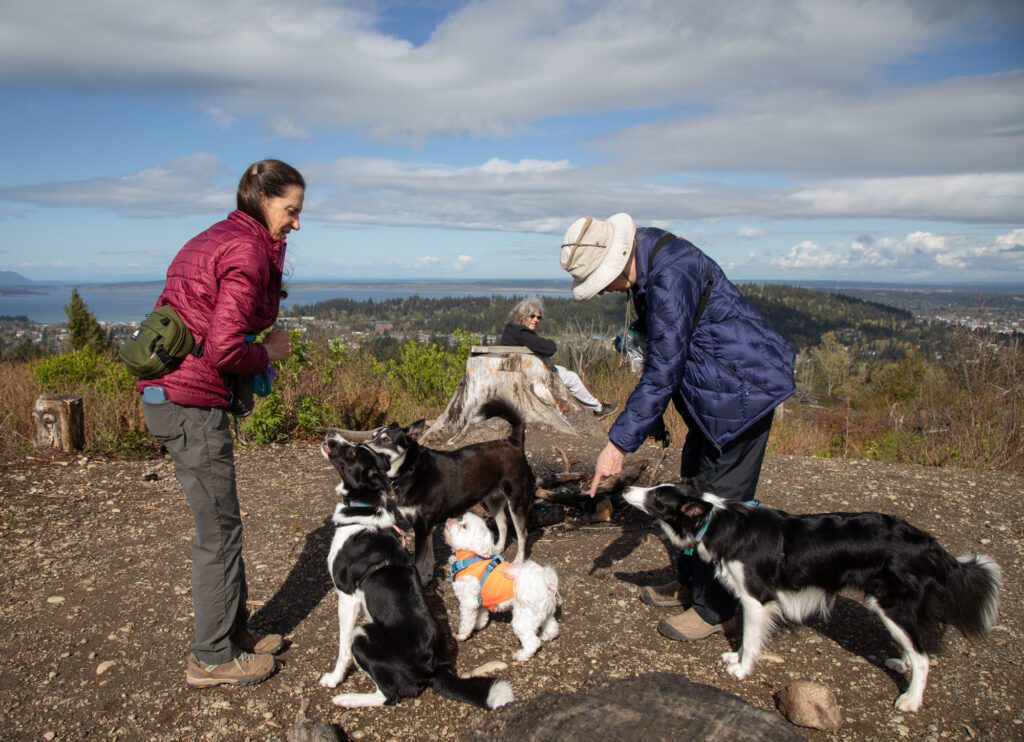
Below the logged land, Whitewater Drive, off of 40th Street in the upper Samish neighborhood, now dead ends at a gated entrance to the proposed hilltop development. Here, 20 lots were platted and sold as Phase I of Samish Heights in 2006.
Seguin and Jepson shared a much grander vision for the hillside; the subdivision master plan shows two phases and meandering neighborhood roads dotted with cul-de-sacs and dozens of large residential lots. The master plan has never been reviewed by the city, because no development is allowed until the questions of water and roads are cleared up.
New state laws have added complexity of the planning process. According to House Bill 1220, the city must not only plan for residential growth, but must plan for residential growth split into percentages based on household incomes. In other words, Bellingham can’t just approve a thousand low-income apartment units; it must account for households who earn up to and above the area median income. Consultant Taysi believes that Samish Heights development could help address some of those higher-end needs; even luxury duplexes and hillside McMansions count as housing for someone, he reasons.
At the same time, a state law passed last summer to address the “missing middle” of housing allows up to four units on single-family residential lots, which would greatly boost the density of areas like Samish Heights.
But spending eight digits on the potentially lucrative Samish Heights property means taking a gamble, broker Prestlien acknowledged. This hypothetical glut of housing all depends on major infrastructure investments, whether from the city or from the few large landowners locked in an island of service-free property.
“That’s the challenge when trying to find people to buy this land,” Prestlien said. “They’re going to have to hang in there for however long it takes for the city to come to some decisions.”
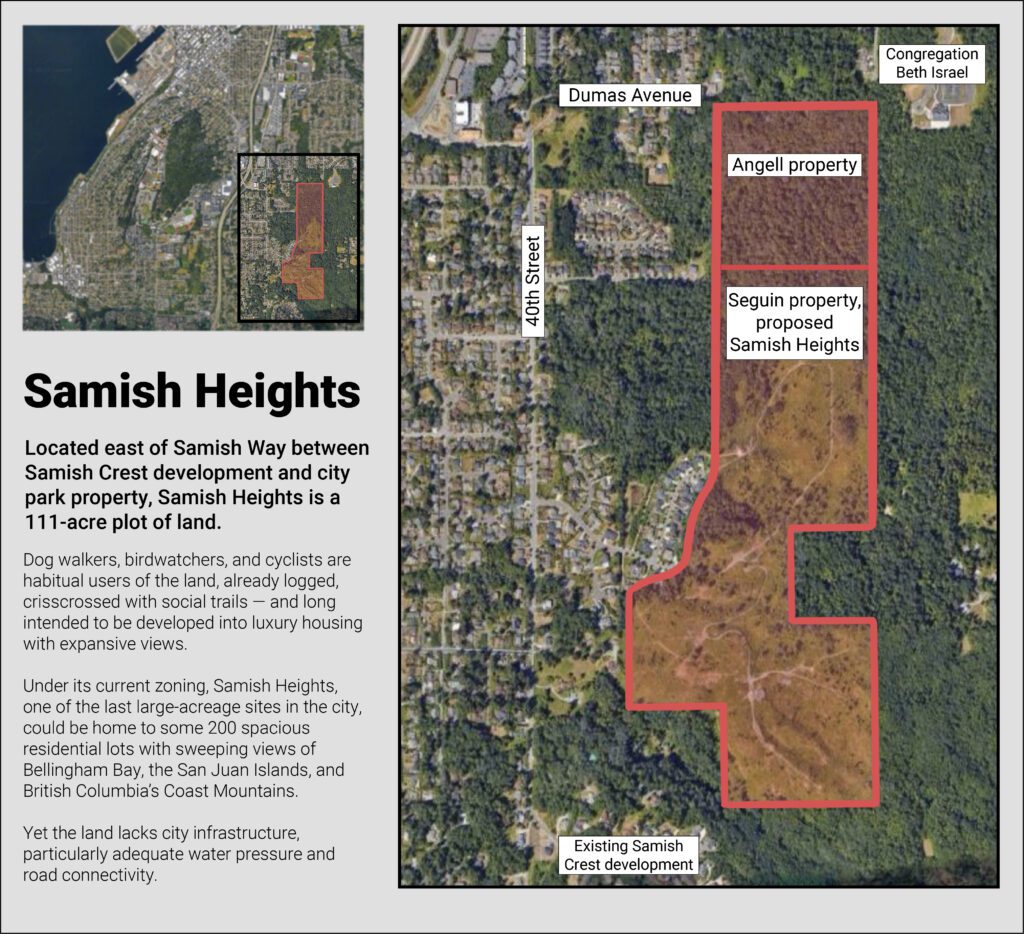
Some possible funding mechanisms for road projects, aside from federal grants or private spending, include the Economic Development Investment Program, which uses sales tax to finance public facilities; a local improvement district, which levies a certain amount from each adjacent land owner; or tax increment financing, in which the city borrows against future tax revenue that will be realized thanks to public infrastructure improvements.
“These major landowners are definitely interested in being involved, but what you really need is a sophisticated team at the mayor’s office and public works office that understands the infrastructure and how it connects to the funding, because that can be really complicated,” said Taysi.
What about the trails?
In other words, there probably won’t be much action around the broader area generally known as Samish Crest for at least a few years.
Seguin had part of the forested Samish Heights property “thinned” in 2017 and another 70-acre portion clear cut in 2019. As part of the DNR forestry permit, a 10-year development moratorium was placed on the logged property, which will end by the supposed time of construction of the hilltop water reservoir in 2028. Jepson said that if the city had changed its infrastructure requirements to pave the way for development, the clear cut likely wouldn’t have happened; Seguin used the timber harvest to offset property taxes on the vacant land.
“I thought we’d actually get more opposition to that cutting, but we didn’t,” Jepson admitted. “It opened up the view.”
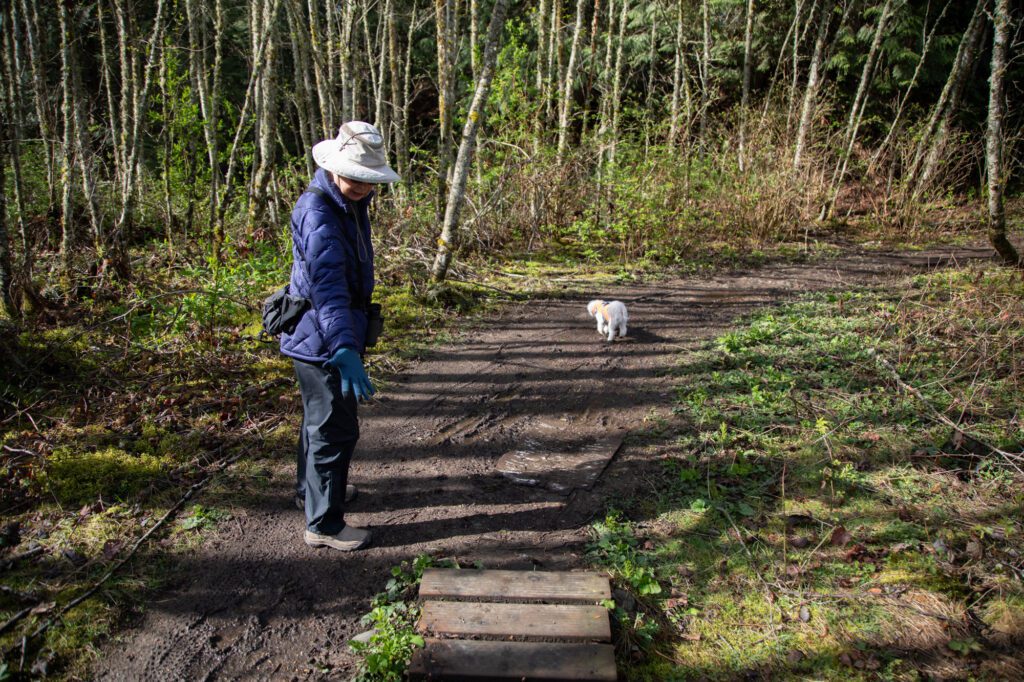
Dina Dickerson, a retiree with a background in health information systems, is one of the many residents who enjoy that view. She lives below the ridge near Lake Padden, and because she loves walking on nearby trails with her dog and wanted to advocate for safe connections in the area, she joined the city Greenways committee, then helped found the Samish Neighborhood Association Greenways Committee (SNAG).
Enlisting longtime residents who have an intimate familiarity with the cobweb of footpaths on Samish Hill, Dickerson assembled a database of around 200 trails, intersections, spurs and points of interest, with comments on each segment’s steepness, width, level of erosion and trail surface. With user-created Strava heat maps, she determined that the most heavily traveled paths pass through private property, especially Samish Heights.
Some have been resistant to sharing their secret stashes with the committee and bringing public attention to the network on the hill, but Dickerson pointed out that if the trails aren’t legitimized, there is no guarantee that they’ll exist in the future.
“It’s like, do you want them protected or not?” she asked.
SNAG’s volunteer efforts have been well-received by the city’s Parks and Recreation Department, which doesn’t have the resources to do such a thorough inventory of the area.
Other private lands as protection prologue?
Through its Greenways program, the city has slowly acquired a constellation of properties dotting the hillside. According to the Bellingham Parks, Recreation, and Open Space Plan, the end goal is a north-south greenway that connects Whatcom Falls Park to Lake Padden, with wayfinding signs, dog waste stations, and parking at different neighborhood trailheads.
Central to that effort is the existing “official” path through the expanse, the 1.7-mile Samish Crest Trail, which runs along the ridge between Racine Street and Governor Road.
Other popular open spaces in the city evolved from private land; the Chuckanut Community Forest (now part of the Hundred Acre Wood) was acquired by the city in 2011 after the failure of several development proposals in the preceding decades, largely due to financing troubles.
Seguin has no intention of carving off portions of Samish Heights to sell to the city, but because of the undulating topography, future development on the hill will probably be clustered, leaving some steep terrain and wetlands undisturbed.
“On the Greenways committee we’re very mindful of the need for housing, and we’re not saying everything has to be open space, but people up here just love the Samish Crest,” Dickerson said.
Seguin and his project team are well aware of the public’s fondness for the land, and have made no effort to keep people off it. Rather, Jepson said, they too have surveyed the most popular sections of trail, to possibly establish them as pathways in a future development.
“Jack asks me if we’re going to live long enough to see any of this built,” Jepson said with a laugh. “But first we and the city have to answer the questions that can’t be answered.”
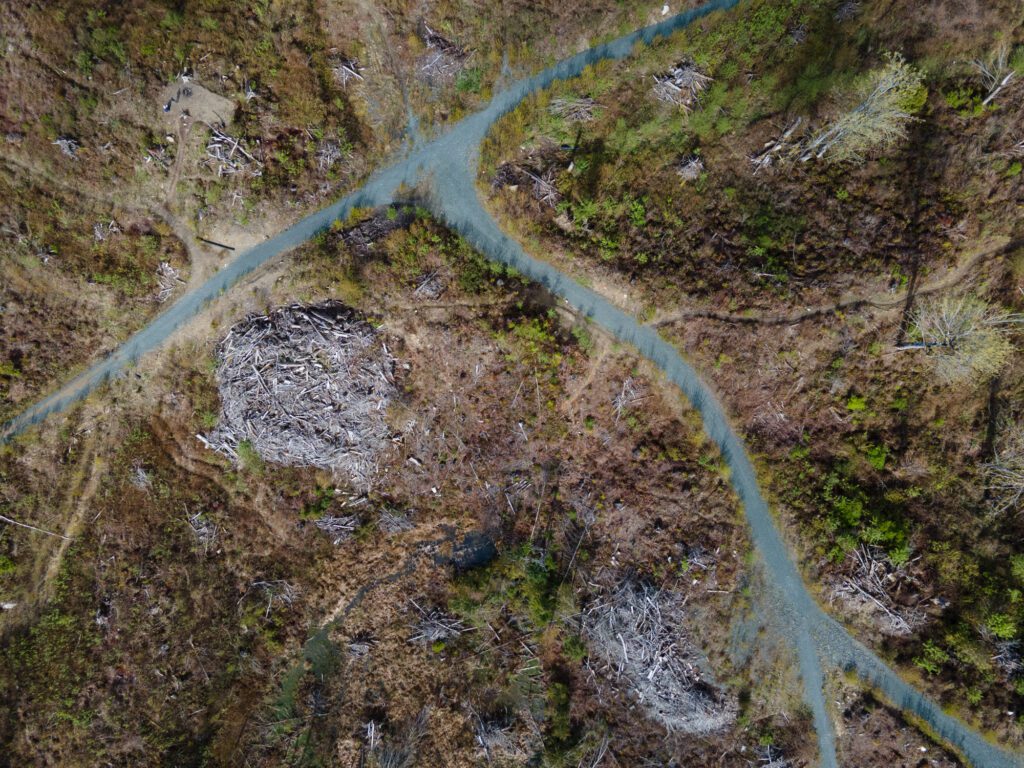
Regular news contributor Julia Tellman recently moved to Bellingham to spend as much time as possible on two wheels or two planks in a recreational wonderland. Reach her at juliatellman@cascadiadaily.com.

